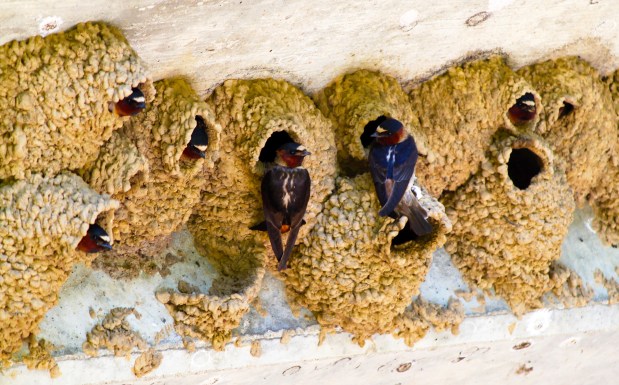After the frenzy of searching for migratory birds and spring wildflowers in May, it’s time to enjoy nature in June before the extreme heat sets in. My sister and I found the perfect place to do so, seated on a paddle boat at Independence Grove Forest Preserve in Libertyville.
Occasionally, we stopped pedaling and sat still, inhaling the soft air amid a light breeze and warming sunshine. There’s no other time of the year when you can experience this kind of peaceful aliveness.
Bordering the lake were trees all leafed out for the season. The leaves were a June-kind-of-green, we noted, not the May-green of emergence, but a hue of freshness. The green will take on an even different color in July, perhaps darker.
We paddled slowly toward a small bridge where we encountered a bevy of cliff swallows. They flew erratically, perhaps wondering what we were doing there, while flashing buffy-colored rumps and white foreheads. We heard their buzzy “chur” calls, and saw them fly to their gourd-shaped mud nests placed on vertical walls beneath the bridge.
This is their time and their place.
If you want to see swallows actively raising a family, now is when to look. Barn swallows, with their forked tails, and tree swallows with their white underparts and iridescent blue backs, are the more common swallows in our area.
Cliff swallows are much less common, though increasing in numbers in Illinois. These six-inch birds with square tails flew to this bridge from as far south as the southern tip of South America, where they spend winter.
Once nesting along mountain cliffs along the western North American coast, cliff swallows accepted human offerings of horizontal overhangs, such as bridges, including over concrete highways, near fields and ponds. The species has expanded eastward to the delight of Illinois birders who enjoy watching them catch insects on the wing and bring wads of mud to their nest sites.
This is the same species of swallow that for many years returned to the city of San Juan Capistrano, California, in late March to begin nesting. Though many fewer cliff swallows return to Capistrano these days due to development and other factors, the people there continue to celebrate weeklong festivities to herald the birds’ arrival.
Certainly, it is a joyous occasion, but on this June day, I prefer to be paddling quietly past the bridge where the swallows are nesting.
Outdoors:
We ventured farther out into the lily-pad-laden water, with a few golden blooms and the promise of many more. The plants are called spatterdock or yellow pond lilies. These native plants have large, heart-shaped leaves rising just above the water, and produce 2-to-3-inch round blooms that look only half open even when in full flower.
We sat in the boat amid the lilies, touching a leaf pad or two, where eastern pondhawk dragonflies will soon alight.
Spatterdock grows in shallow waters near the shoreline, and as we looked to the land beyond, we heard the unmistakable call of another swallow species, the purple martin. We saw four small apartment-like complexes raised on poles, and this is where the martins nest. Deep jet purple males and light brown females flew in and around the purple martin houses, or out to the air to catch insects.

Purple martins traditionally nested in woodpecker holes and other natural cavities. Some still do so in the western United States, but here in the east, they mostly use manmade structures. Native Americans, it is believed, once set up hollowed-out gourds with holes in them to attract the nesting martins.
Each of us has certain sound memories of summer, and for me, it is the purple martin’s various vocalizations – from rattling chirps to squeaky rattles. Purple martin calls remind me of family vacations when we would encounter them near water. It is the sound of June opening its gifts to the Earth.
In a few weeks, the summer solstice will occur and we will celebrate the longest day of the year. But truly, I prefer the earlier part of June as spatterdock is beginning to bloom and swallows skirt the sky above my head.
Sheryl DeVore has worked as a full-time and freelance reporter, editor and photographer for the Chicago Tribune and its subsidiaries. She’s the author of several books on nature and the environment. Send story ideas and thoughts to sheryldevorewriter@gmail.com.




